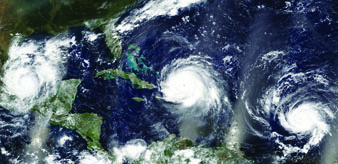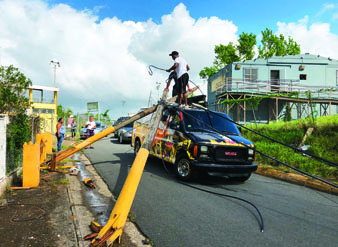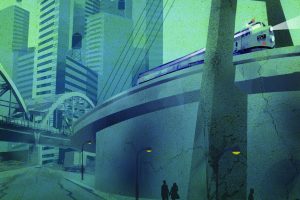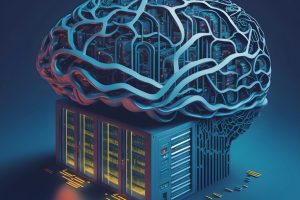By Pablo Olmo
My experiences with hurricanes Irma and María in 2017
Preamble
Living through storms as a child teaches you invaluable lessons that cannot be learned without firsthand experiences. I was born and raised in San Juan, Puerto Rico, which means that by now (at 38 years old) I have already experienced a couple major hurricanes and over three dozen hurricane seasons. The word, hurricane, originates from the native Taino population which inhabited the island centuries ago.
When a major storm approaches the island, everyday life and all normal business activities in Puerto Rico come to a halt. Instead, citizens prepare for possible food and gas shortages. Schools and businesses usually close early to allow families to get ready for the worst. Residents will stack up on food, water, and gas and make sure they have all basic provisions they might need. They will then hurry home to put away all outdoor items, shut all windows, install any storm covers (tormenteras) they might have, and lock themselves tight, bracing for impact.

A heavy storm, like Hugo in 1989, will cause widespread flood and water damage as well as destructive, high-velocity winds. It’s also quite common to see hurricane winds uproot trees and detach semi-permanent structures like zinc roofs, sending those and many other objects flying into the air, becoming projectiles. Roads get obstructed by trees, broken branches, landslides, and debris making it impossible to access and exit some areas. Power outages are likely to occur due to damaged stations and interrupted power lines. Water service will most certainly become interrupted as well. Access to utilities might not be restored for weeks or even months. Portable radios become the most reliable source for storm updates and official reports such as efforts to provide access, restore utilities, save lives and where and how to obtain help in case of need.
Eventually, the storm passes, roads get cleared, services restored, and the island rebuilds itself back into normal, everyday life. It is a process that can take days, months, or even years.
Hurricane No. 1
On Sept. 7, 2017, Hurricane Irma, a category 5 storm, passed just north of Puerto Rico. The storm’s heavy winds and rain impacted mostly the east and north coasts of the island. This atmospheric event caused electric and water service interruptions, landslides, and damaged roads. Still, residents were relieved that the island had narrowly avoided a category 5 hurricane.
At the time, I was acting as chief actuary at a local life insurer. The company had adequately prepared itself for a major hurricane—it had installed a state-of-the-art diesel generator, purchased business disruption insurance, and implemented robust disaster recovery plans across different departments. The company’s headquarters consisted of a recently built 10-floor modern office building next to a six-story parking lot with sufficient space for over 200 vehicles, and an older six-floor office building which was mostly rented out to small firms.

Irma hit the island on a Thursday and the company was already fully operating the next Monday. Power service had not been restored in the area, but we had enough diesel fuel to power the office building complex for 10 business days. That week it was back to business-as-usual at the life insurer, except for the fact that we were running on diesel fuel and the cleanup crew had a month’s worth of damages to fix. Employees would bring their power cords to work to charge their mobile devices as many were still without power at home. Little did we anticipate that Puerto Rico would be hit by a second major hurricane just a couple of weeks later.
Hurricane No. 2
When the government alerted the citizens of Puerto Rico of the upcoming threat caused by Hurricane María, many businesses, agencies, municipalities, as well as the central government were all still recovering from losses caused by Irma. My company did not get a chance to replenish its diesel fuel reserves, as resources had run low after the first storm and our supplier had not refueled the tanks in time. Once again, we had to drop our pencils and stop what we were doing to begin getting ready for María, as this menace of a storm was most probably going to hit us.
María, now a category 4 hurricane, stormed through Puerto Rico with peak winds of 155 miles per hour.[1] Hurricane María caused widespread damage, disabling all electric power grids across the island and over 95% of cellular communications as well as leaving over 95% of the population without drinking water.[2] More than 40,000 landslides occurred and over 97% of roads became impassable.[3] Almost 3,000 people (approx. 0.1% of population) lost their lives.[4] The island had not witnessed such a destructive storm since Hurricane San Felipe II back in 1928.[5]

María hit the island on a Wednesday morning. A lone security guard spent the night inside the lobby of the main building to pass the storm. He proudly worked consecutive shifts to protect the office complex from post-storm vandals that are known to roam the area after events like this occur.
Operational Risks
The company was not able to recover as quickly from the second storm. Neither were its employees, some of whom even lost their homes.
While the company was fully operating just two days after Irma, this time it took more than a month to be able to fully allocate all employees back at the office. The damage to the facilities was considerable. Entire floors were flooded by the heavy rains, including my department’s area, which had an outside balcony through which water had found a way to ransack and completely ruin all the furniture, walls and carpets while also leaving behind a humid trail of mold and mildew. It took months for the company to completely restore working conditions.
Priority Shift (Human Risk)
Three weeks after the hurricane, I was still under orders from my boss to stay at home due to lack of workspace. The Actuarial Department itself spent over six months working from a conference room at the first floor that had enough capacity to seat and provide network connection for my six-person staff.
Priorities had shifted immensely for the company after the storm. The company had low fuel reserves and it could not afford to bring back non-essential employees prematurely. Due to heavy demand and obstructed roads, our diesel supplier could not deliver for several days. IT staff became the primary resource for the operation’s business resumption efforts. Software and computer engineers had to prepare provisional workstations and restore system access in order for employees to be able to process claims. Access to claims and customer service personnel was prioritized as workspaces were limited. Accounting and billing staff would then switch off days in order to share the limited spaces that were left available.
Food shortages affected the company’s ability to operate. The cafeteria was unable to open for weeks mostly due to lack of fuel but also because of scarcity in food supplies. In order to provide safe working conditions under such uncertain circumstances, the company had to provide food and water for all employees showing up to work. Fortunately, our sister Property and Casualty company, conveniently located across the street from us for decades, was kind enough to let us access their cafeteria, which was open for its employees.
Credit cards wcould not be processed, ATMs were cashed out, and traditional checks were not accepted as widely as they used to. I purchased a bicycle to ride to work for $200 cash to avoid using my vehicle’s precious gas reserves. Gas stations had hours-long lines and it was a 15-minute bike ride from home to work. It was a delicate time for everyday life in the island.
Communications Risk
Two weeks after the storm, on October 4, the Office of the Commissioner of Insurance (OCI) issued Normative Letter number CN-2017-222-D, declaring a moratorium on policy cancelations due to lack of premium payments. The letter stated that no insurer could cancel a policy or deny renewal of any contract because of missing premium payments during the state of the emergency. This was due to the widespread interruptions in communications and power services that the island was struggling with. Commissioner Javier Rivera Ríos amended the order after issuing CN-2017-227-D, which clarified that the moratorium would extend all grace periods for an additional 30 days. The OCI requirement would present an additional risk of excess lapses. Insureds now had the option to either pay all their premiums in arrears or to let their policies lapse, thus possibly saving a couple months’ worth of premiums.
Cash flows were stalled due to lack of new business and diminished inflows from in-force clients. For the accounting staff, this meant having to get creative when estimating accrued premiums or risk having to write down balances in the near future. For the actuarial staff, it was an exercise in estimating claim reserves after an unprecedented disruption in claim patterns. The company had only about three months remaining before the end of the fiscal year (December 31).
Financial Risk
The insurer’s financial results were severely impacted by Hurricane María as well. Revenue fell across all product lines. Credit life, the company’s most profitable product line with approximately $10.6MM in 2016 premiums, suffered almost a 10% reduction in premium income. Group Life ($9.1MM in 2016 premiums) saw a 6.5% drop in premiums while Group ADD revenues dropped by over 11%. Supplemental Health products, with almost $15.5MM in 2016 premiums, did contribute to offsetting these sharp reductions in income, retaining almost 99% of its revenue compared to the previous fiscal year. The company was also facing pressure from increasing claim costs and loss ratios. Credit life and Group Life incurred loss ratios jumped by 4% and 3%, respectively.

Product diversification played a key role in limiting the financial impacts of the life insurance business. Supplemental health products saw a sharp drop in utilization, mostly due to poor access to health clinics and facilities. Cancer screenings and preventive testing were halted for weeks, even months, after the hurricane. This led to a drastic 77% drop in claim costs for a total reduction in incurred claims of $2.9MM compared to the previous year.
Model Risk
The Life incurred-but-not-reported (IBNR) calculation became a challenge. Communication and customer access issues were evident in the available claims data and our traditional claim triangles were not providing proper estimates. Historically, since 2016, the company would pay an average of $2.1MM in monthly life claims. It paid just over $900K in September, approximately $1.3MM in October, $1.7MM in November and still had not reached its pre-María levels by December. Given these results, I decided to transition to an expected claims calculation, as it was likely the most appropriate reserve estimation method.
The CFO and CEO challenged the transitory Life IBNR calculation thoroughly. While they agreed with me on the results of the Health IBNR decreasing from the previous year balance by 40% (over $2.0MM), they were not equally accommodating of the life IBNR increasing by $2.6MM, over 70% from the previous year balance. Eventually, they were able to accept the reasoning behind the change in methods.
Final Remarks
I wrote this article with the intention of providing readers with a unique case for managing risk through a catastrophe. Given that the aforementioned are usually isolated and uniquely presented events, there is no comprehensive guide on how to manage an insurance company through a catastrophe. Each case will present different challenges and difficulties, but perhaps some of the elements in my story may become present in yours. While I hope that no one ever has to go through such an extreme experience like María again, it is more than likely that we will.
PABLO OLMO, MAAA, FSA, CERA, is vice president of actuarial affairs at First Medical Health Plan in Puerto Rico.
Endnotes
[1] “Hurricanes Irma and Maria: Impact and Aftermath”; RAND Corporation. Accessed at https://www.rand.org/hsrd/hsoac/projects/puerto-rico-recovery/hurricanes-irma-and-maria.html onJune 4, 2021. [2] Id. [3] Id. [4] Id. [5] Id.




